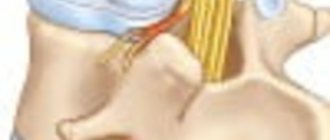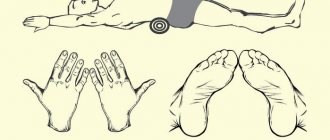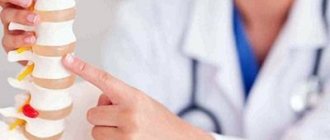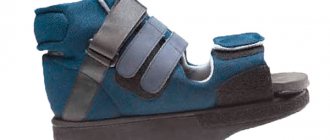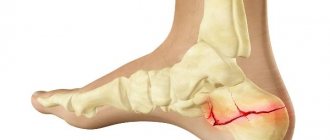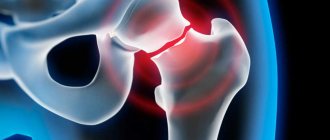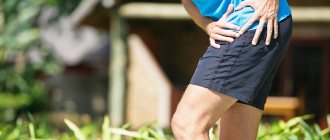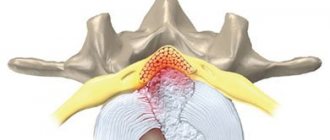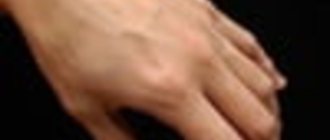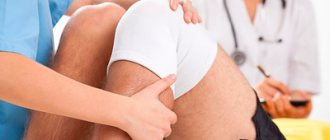Today, the incidence of intervertebral hernias among the population and the number of operations performed due to the progressive course of the pathological process have reached incredible proportions. Statistics show that approximately 25% of people aged 25-30 years begin to feel the first clinical signs of an insidious disease. And by the age of 50, intervertebral hernias cause significant trouble for 80% of men and 60% of female patients. Often the disease is uncontrollably aggressive, which inevitably requires surgical treatment.
Bulging on x-ray.
Fortunately, despite the incurability of degenerative-dystrophic pathogenesis of this type, modern methods of surgery generally cope well with their therapeutic task: they completely eliminate the pathological factor (hernial component), which provokes compression of the spinal structures. Thus, after the operation, complete decompression is achieved, and at the same time, excruciating pain disappears, and functional disorders of the musculoskeletal system and internal organs are eliminated.
However, you should not think that surgical intervention for hernias of the lumbar spine and other locations is the only and final stage of treatment. No, in order for the manipulations performed to really lead to the cherished recovery, it is extremely important to undergo high-quality postoperative recovery from beginning to end. After surgery to remove a herniated disc, the rehabilitation period must be properly planned by a professional.
Natural image.
The patient will be required to complete the entire rehabilitation period established by the doctor, which will take an average of 3 months, and to very responsibly follow the postoperative treatment program recommended by him. Depending on how the recovery process goes, how long the wound heals, etc., the time frame, in principle, can be shortened or extended. The duration of recovery will be different for everyone, as will be the scheme of treatment measures. It is worth noting that the best results are achieved by people who have recovered for the prescribed amount of time under the supervision of experienced rehabilitators.
Goals and objectives of recovery after deletion
After surgery to remove a lumbar hernia, as well as prolapsed cervical or thoracic disc cartilage, the recovery period is necessary for:
- quick relief of pain;
- prevention of possible complications (infections, thrombosis, scars, etc.);
- bringing general health indicators back to normal;
- restoration of muscle strength in the legs, arms, back, abdomen;
- gradual restoration of the spine;
- mastering the skills of proper load distribution;
- correction of gait and posture defects;
- return to normal life with a minimum of restrictions;
- minimizing the risks of reoperation.
Conventionally, the entire rehabilitation period is divided into 3 stages, where the 1st is the most severe stage, during which pain in the suture area will bother you; some people may also have residual neurological symptoms, which is normal after such an intervention with this diagnosis. Within a week, the painful signs in the area of the surgical incision will disappear, the wound will have healed well, and then recovery will be much easier to bear.
The early stage lasts about 2 weeks, therapeutic measures in this phase are aimed at eliminating swelling and pain, maintaining normal respiratory organs, normal regeneration of injured soft tissues, preventing infectious pathogenesis, preventing muscle atrophy, as well as thrombus formation in the lower extremities. Physical activity is still limited to a light form; you are shown getting up and walking after 24 hours; sitting is prohibited. In addition, special breathing exercises, simple exercises in bed, and wearing a corset are recommended.
One of the types of corset.
At the 2nd and 3rd stages, the treatment process is largely based on exercise therapy, it is already more active and varied, and in parallel with it, physiotherapy sessions are indicated. Closer to the final stage, massage and manual therapy procedures, therapeutic exercises in water, and swimming lessons are prescribed.
The main thing for you now is to tune in to long, hard and fruitful work, not to be lazy or lose heart, and not to deviate from your goal. You will definitely get better, begin to live a full life, free from the pain and limited mobility that for years have chained you, literally, hand and foot. Let us repeat that a successful outcome is possible only with the ideal fulfillment of rehabilitation requirements.
Physiotherapeutic treatment
The recovery period requires the mandatory implementation of certain physiotherapeutic procedures. These include:
Wearing a corset during the rehabilitation period
- Iontophoresis is used to eliminate pain, speed up the healing process, and improve the penetration of medications through the skin.
- Mud wraps have a pronounced analgesic, absorbable, and anti-inflammatory effect.
- Ultrasound stimulates restoration processes in cells.
- Extremely high-frequency therapy is used to normalize blood circulation and restore muscle tone and ligamentous apparatus. This treatment perfectly eliminates pain and inflammation.
- Interstitial electrical stimulation – helps restore pinched nerve endings and normalizes the nutrition of bones and cartilage.
- Phonophoresis – provides ultrasonic administration of medications. Due to mechanical action, it is possible to achieve anti-inflammatory and anti-edematous effects.
- Magnetotherapy – helps to activate metabolism, reduces the threat of pain and swelling, and is recommended for inflammatory processes.
Exercises after removal of intervertebral hernia
In exercise therapy, the main principle is consistency in the recommended exercises and the patient’s well-being, dosage, gradualness and regularity. If the condition is satisfactory, the range of activities should be very carefully expanded, while carefully listening to one’s own sensations, avoiding the appearance of painful discomfort or exacerbation of residual pain and sensory disturbances in the limbs.
If, while performing any exercise, you feel pain in the lumbar region or in another place where you had a hernia removed, as well as in your arms or legs, it makes sense to reduce your range of motion. But it is better to immediately stop using this gymnastics technique, see a doctor and describe the situation to him in detail. A qualified doctor will examine you and correctly adjust your physical activity regimen.
Just as surgical intervention for herniated intervertebral discs, each individual patient has its own specifics and level of complexity; moreover, it can be used on completely different areas of the spinal column, and the exercise therapy complex cannot be universal for everyone. Additionally, we note that the age, weight criteria and health status of the patient must be taken into account. Thus, you should only have a specialist compile exercises, videos and any other sources are extremely risky to use.
Remember that with the wrong approach, self-prescribed therapeutic exercises, as well as its absence or irregularity, you risk worsening the rehabilitation prognosis. Even such a moment as whether it is possible to squat and when, and that is decided by the doctor. By the way, it is usually not recommended to take a deep squat position until six months, although this time parameter, as is easy to understand, is also subject to the principle of individuality. We will highlight several more important aspects related directly to physical rehabilitation:
- training is not sports, but a special therapeutic (!) warm-up, where the goal is an optimized and correct restoration of lost functions of the musculoskeletal system;
- You cannot do classic push-ups at the beginning of recovery, at first you are limited to push-ups from the wall;
- during rehabilitation, avoid intense and sudden movements, do not swing your legs, jump, deep bends, sharp turns of the body along the axis, hanging on the horizontal bar, any power and shock-impetuous loads;
- do not lift heavy objects, the maximum permissible load weight for you is 4 kg, try not to lift heavy objects after recovery is complete;
- during training, always wear a special orthopedic corset or collar;
- do not take the “sitting” position for exactly as many weeks as your doctor told you;
- be sure to include calm walking walks in your daily regimen, preferably in the fresh air, but do not overdo it with the duration and alternate walking with half-hour rest breaks.
The early complex, which is mainly prescribed by rehabilitation therapists in the very first days after surgery (performed in bed), is based on techniques such as:
- circular rotations in the ankle, wrist;
- movement of feet up/down;
- flexion/extension of legs at the knee, elbow joint;
- alternately pulling the knees to the stomach;
- tension/relaxation of individual muscle groups;
- breathing exercises.
But this is just the beginning; further, much more complex exercises will be used, which already involve performing a variety of active tasks for stretching and strengthening the muscles of the back, neck, abdominal wall, lower and upper extremities in several positions: lying on the stomach, lying on the side, standing on on all fours. In addition, in the later period they actively practice classes on special simulators, aqua gymnastics and swimming in the pool.
Late period
The rehabilitation period is one of the most significant treatment methods. If you take this seriously, you will be able to significantly improve your health. When performance is restored, a delayed phase occurs that lasts throughout life. Doctors monitor the process of strengthening the muscle corset. Exercises to strengthen muscle tissue are more active.
The main methods of recovery include massage and manual therapy. Blood flow improves, the patient’s vital functions are normalized, and prevention is carried out.
In the late period, doctors recommend:
- Do not carry things heavier than 5 kg.
- Do not sit or stand for long periods of time.
- Do not move suddenly, do not jump.
- Avoid cold, wrap warm clothes around your lower back.
- Wear a corset less often.
- Strengthen your back muscles.
- Follow recommendations for nutrition, activity and rest.
Gymnastics and exercise therapy after removal
From a lying position, raise your leg bent at the knee.
From a lying position, extension and abduction of half-bent legs.
The picture shows how the exercise is performed 
Lift the pelvis off the surface.
Straight leg raise.
Bend your chest VERY slowly.
Pull your chin towards your chest.
Straightening the arm and opposite leg.
At the same time, lift your head and legs from the surface and slowly lower them.
Simultaneously raise the right arm and leg, then the left.
Extension and abduction of legs.
Corset after hernia removal: role, terms of wearing
A prerequisite for anyone who has undergone surgery is to wear a corset. First, let's figure out how long you will need to wear the orthopedic device. According to postoperative standards, it must be used for at least 2 months, 3-6 hours a day.
The second type of corset with fixation of the thoracic region.
They wear a corset during physical education, household chores, and walks. Traveling in vehicles and cars is now contraindicated, but if such a need urgently arises, you must be in a corset at the time of the trip. The support product is removed every time before sleeping at night and during the daytime; to do this, you first need to lie down and then remove the corset.
The orthopedic device must be of a semi-rigid type . It plays a fixing and supporting role, providing reliable support and relieving stress from the spine. With it, the operated area will recover faster, as it will be maximally protected from overload and unacceptable sudden motor maneuvers. In addition, the corset helps reduce pain.
Physiotherapy
Exercise therapy plays an important role in the process of rehabilitation of the body. The exercises are aimed at performing the following tasks:
- restoration of muscle tone in the neck and lumbosacral region;
- prevention of congestion in the back, which can result in swelling and adhesions.
Charging should be done literally from the very first day after surgery. To do this you need to do the following types of exercises:
- Pull your knees towards your stomach, then straighten your legs. The movement should be repeated several times.
- Bend and straighten your legs at the knee joints.
- Make circular movements with your feet, then raise and lower them up and down.
These movements must be performed throughout the recovery period.
As you recover, the load should gradually increase. Throughout the rest of his life, the patient should perform the following gymnastics: Squats. These types of movements should be performed as if the person is about to sit on a bench. Deep squats are contraindicated. The intensity is affected by the general condition of the patient. As a rule, you need to do 10-15 repetitions. Push ups
This is a very important gymnastic exercise, which should also be done 10-15 times. You need to exhale air when lowering your body down, and when lifting it, you should inhale it. Bike
The lower the leg is, the higher the intensity of the load. You should start with 10-15 repetitions, then increase the number of repetitions to 100-150.
When can you sit down after surgery?
It is prohibited to decide on your own when you can sit down; this restriction can be lifted only by a competent specialist. Depending on the severity of the operation, as a rule, a complete ban on taking the “sitting” position lasts approximately 4-6 weeks. After the restriction is lifted, you will be taught how to sit down correctly, but at first you will only be able to sit down without putting stress on your tailbone. Before you begin, make sure that the seating surfaces are not too low. How to correctly take a pose, what deflection of the spine to maintain, how to stand up, and so on, you will learn all this in due time. At first, it is only permissible to sit on the edge of a chair, with your knees below your hip joints. It is necessary to sit and stand with your hands on your knees or chair armrests.
X-ray stabilization system. When using it, you can sit down much earlier.
Rehabilitation rules
After the operation, you must follow these rules. Firstly, the selection of suitable procedures for the patient in order to eliminate his problems. Secondly, regular medical supervision of the body is required. A surgeon needs to act.
During recovery, the following stages are performed:
- During the first 14 days, pain symptoms are eliminated and support from a psychologist is provided. I can walk 3-4 days after the operation. Exercise therapy after repair of the hernia is carried out at this stage. It is advisable to do gymnastics in a lying position.
- During the first 60 days, the patient prepares for everyday life at home. During this period, movements with increased amplitude are not possible, the back is twisted, and bends are made.
- After 90 days, physical activity is maintained, muscle tissue is strengthened, and prevention is performed. This time requires a year after surgery.
You should not sit in a sitting position for 3-6 months, as there will be an increased load on the lower back.
It is unacceptable to drive a car for 3 months. The passenger is allowed to be in a semi-sitting position or take a horizontal position. It is unacceptable to jump, run, or turn the spine. Vertebrae and discs are always injured.
Leg pain after surgery
During rehabilitation, especially in the early stage, residual effects that were present in the preoperative period may persist for some time. And the most common of them is pain in the leg. There is nothing surprising in the fact that your leg hurts or there is still numbness; we will explain why. For a long time, the nerve structures were in contact with the hernia, which put pressure on them and irritated them . Affected nerves after decompression cannot immediately recover as soon as the pathological stimulus is removed. That is why the lower leg still hurts or, for example, the thigh is pulled, and numbness and weakness in the leg are disturbing.
It may take more than one week to restore the sensitivity of the problem root and normal nerve conduction. But in any case, there should be progress in the near future. If improvements do not occur, pain and paresthesia tend to intensify, or against the background of complete well-being, the leg suddenly begins to hurt and go numb - these are alarming signs, often indicating the development of complications or relapse of the disease. Don't hesitate to ask your doctor questions, ask why your leg hurts and if it's normal for you, after all, it's in your best interest. The earlier a negative factor is diagnosed, the greater the chances of a positive prognosis.
Degenerative diseases
In degenerative disc disease, the distance between the vertebrae shortens, causing the discs to wear down, which can lead to the formation of a herniated disc.
Degenerative processes can also develop in the joints of the spine (facet joints) or bone tissues with the development of spondyloarthrosis (spondylosis). Degenerative processes in the spine can lead to compression of nerve structures (spinal stenosis or root compression) with the development of symptoms such as pain, numbness, muscle weakness or dysfunction of the pelvic organs.
Recurrence of hernia after removal surgery
Yes, such an outcome, unfortunately, cannot be ruled out. The probability of such a complication as relapse cannot be said to be negligible, it ranges from 5% to 10%. And no surgeon will give you guarantees that in the future there will be no re-exacerbation, either on the same disc or any other, even with a perfectly performed operation. More often, repeated attacks occur in the lower back, after the lumbar region, but with fewer cases, the cervical discs are affected. The most common reasons are surgeon errors, poorly organized rehabilitation, and patient neglect of lifelong rules.
It is not difficult to suspect such a complication, especially for people who are familiar with the clinical picture of hernias firsthand. In addition to pain, loss of sensitivity and decreased motor functions of the limbs, a person may also be troubled by disorders of the pelvic organs. Some complain that urine leaks as a result of impaired innervation of the bladder, which is controlled by the spinal nerves. We emphasize that these symptoms may indicate both a relapse and damage to the spinal cord, nervous and vascular tissue with surgical instruments, as well as serious atrophic processes, etc.
Do not try to solve a problem with a complication by turning to osteopaths and other alternative healers, you can worsen the condition to the point of irreversibility. Although osteopathy has some recognition in the treatment of neurogenic syndromes arising from the spine, in our country, frankly speaking, this area of medicine has not been mastered at all. But there are a huge number of amateurs offering low-quality osteopathic sessions. But this is not what we are talking about now; it is important to understand that the consequences after surgery are always serious and dangerous, since they can quickly turn a person into a disabled person. Therefore, their diagnosis and treatment should be carried out by neurosurgeons and neurologists!
In order to protect yourself as much as possible from a recurrence of the attack and other consequences, you need to undergo the procedure with a good neurosurgeon with many years of successful experience in this area and, of course, unquestioningly fulfill all the requirements for rehabilitation and future lifestyle.
Postoperative complications
Surgery is not always performed perfectly, resulting in complications. During anesthesia:
- When anesthesia is given, changes occur in the esophagus or trachea.
- Allergy to the constituent substances of anesthetics.
During the operation, blood pressure decreases. The heart stops beating and breathing problems arise. Damage to the spinal lining, which causes chronic migraine. The infection enters the cerebrospinal fluid.
Deformation of the recurrent nerve causes loss of voice and breathing problems. After a few months, the nerve recovers on its own. High probability of deformation of the nerve roots. The spinal cord is injured, paralysis, neurological disorders, and other pathologies occur.
To study What doesn't our spine like?
Postoperative:
- Osteomyelitis - ulcers affecting the functioning of the vertebrae. As a result, the spine may break.
- Stenosis. The spinal cord is compressed and repeated surgery is required.
- Recurrence of the herniation at the surgical site can occur one year after repair of the disc herniation.
- The vertebrae and intervertebral discs change their position, resulting in a hernia or protrusion.
Surgical removal does not cause disability. If you follow the recommendations of specialists, the resumption of a normal lifestyle will occur in the near future.
Surgery is not the only available way to eliminate a hernia. Pathology is treated therapeutically. Therefore, surgery is performed in the absence of positive results from less radical treatment.
Stages of patient recovery
In fact, all activities after removal are aimed at achieving the main objectives:
- restore the patient's ability to work;
- prevent the development of negative reactions after surgical invasion;
- prevent the formation of new intervertebral hernias.
As we said earlier, the rehabilitation program consists of 3 stages. Let us now consider what treatment and rehabilitation measures are meant by them.
| Stages | Deadlines (approximate) | Therapeutic approach |
| First (early recovery treatment) | 0-15 days |
|
| Second (patient readaptation) | from the 3rd week up to 2 months after operation |
|
| Third (return to normal living conditions) | from the 9th week until full recovery |
|
It is impossible not to voice a very important point regarding women of childbearing age. To avoid relapse, do not plan to become pregnant during the first year. Until the spine and musculoskeletal frame are thoroughly strengthened, wait until you conceive a child. We will also warn all patients, regardless of gender and age. Strictly follow the instructions on restrictions and maintain the physical regime that you have achieved after 2-3 months for at least a year. Such recommendations are given by doctors, explaining that after lumbar intervention, the postoperative period during the first 12 months has the highest risk of developing a recurrent hernial protrusion.
Many people are interested in whether they give disability after an intervertebral herniation surgery? In most cases, no, but if, at the end of a full treatment and rehabilitation course, the patient’s condition is extremely unsatisfactory, then, based on the results of a comprehensive diagnosis, the ITU commission decides on the possibility of assigning a group. Disability status is generally given temporarily, usually for a period of six months. The supervising doctor will advise you on how to obtain disability and whether you can even count on it.
For people with positive dynamics and no complications, the sick leave is usually closed immediately after the end of the rehabilitation period. That is, the duration of sick leave will be approximately 2 or 3 months, after which you can go back to work.
Pain syndrome in long-term periods may indicate adhesions after removal of an intervertebral hernia in the lumbar region or another region where surgical procedures were performed. Pathological formations detected untimely are fraught with severe hardening and chronicity of the process; then it is unlikely to be possible without surgery. Therefore, it is easier to prevent them than to then lie down on the operating table again due to the massive and dense cords that have formed in the spine. The best means of prevention is regular physical therapy. Note that clinically significant postoperative adhesive epiduritis, which literally “bricks up” the nerve roots, occurs in 3%-3.5% of cases.
Who is entitled to a certificate of incapacity for work?
A sick leave (SL) in accordance with the current legislation (Order of the Ministry of Health and Social Development of Russia dated June 29, 2011 No. 624n (as amended on November 28, 2017) “On approval of the Procedure for issuing certificates of incapacity for work”) for pathology of the back and spine is issued to citizens when a doctor detects signs in them temporary disability.
To receive a BL, an employee must be officially employed and regularly pay contributions from income (transferred by the employer) to the Social Insurance Fund (FSS).
What should you immediately tell your doctor about after surgery?
7-10 days after removal of the lumbar hernia, the suture is removed. By this time, the incision (size 2-5 cm) is already healing well, local swelling and inflammation disappear, so the surgeon removes the suture material. If the patient feels well, immediately after the sutures are removed, they are discharged from the hospital, explaining how to proceed and what to do. Let’s immediately answer two frequently asked questions: is it possible to take a steam bath and when is it permissible to wet a wound (take a shower)? You cannot visit the bathhouse/sauna for at least 6 months, but you can take a warm shower 3 days after the stitches are removed.
An example of a suture after surgery on the lumbar region.
So, hospitalization in a hospital is over, now the patient is obliged to continue his recovery in an outpatient setting or a rehabilitation center. But since some patients do not consider it necessary to undergo all rehabilitation activities under the supervision of highly qualified rehabilitation therapists and exercise therapy instructors, which is very bad, many of them at one phase or another experience excesses of a different nature, which should be reported to a specialist without delay. Instead of waiting for your scheduled check-up, which could be scheduled after 6 and 12 weeks, drop everything and go to a neurosurgeon if you have:
- the back burns, bakes, burns;
- urination is impaired;
- the lower limb becomes numb and loses strength;
- there was pain in the abdomen;
- my leg and arm began to hurt;
- the temperature has increased;
- back pain suddenly appears and gets worse;
- back muscles spasmed;
- the postoperative wound is swollen or oozing.
In general, modern microsurgical tactics make it possible to undergo surgical treatment with maximum safety and minimal intra- and postoperative risks. However, as after any surgical intervention, the possibility of developing negative reactions exists. In clinical practice, it is rare, but the following consequences occur:
- superficial and deep wound infection;
- purulent inflammation of the spinal cord tissue (epiduritis);
- secondary spinal canal stenosis;
- osteomyelitis, spondylitis;
- progression of osteochondrosis;
- scar-adhesive defects within the surgical access;
- dysfunction of the pelvic organs;
- muscle weakness of legs, arms;
- recurrent intervertebral hernia.
And if some of the listed problems can be eliminated through intensive conservative therapy, then a relapse is an indication for another operation; it may be necessary to completely remove the disc and install stabilizing systems.
Medicines
In the case of a lumbar hernia of the spine, a specialist may prescribe medications to reduce pain or normalize disrupted processes in the body.
Medicines will be an excellent aid during the rehabilitation period
Doctors usually prescribe:
- Muscle relaxants that help relieve muscle tension and reduce pain: Tolperisone, Tizanidine.
- Analgesics aimed at reducing or completely neutralizing pain: Lidocaine, Aspirin, Ketotifen.
- Non-steroidal anti-inflammatory drugs that eliminate inflammatory processes and help get rid of swelling: “Diklak”, “Ketorol”.
- Chondoprotective drugs that help restore cartilage and bone tissue: “Aftulop”, “Arthra”.
Prices for painkillers for back pain
Reviews after removal of intervertebral hernia
As the statistics of reviews show, after lumbar surgery for a vertebral hernia, people are mainly concerned about pain in one of the limbs and in the area of the incision. A common complaint of patients is decreased sensitivity of the lower legs, mainly the feet. If the pain syndrome is not caused by complications, but is interpreted as residual effects or as a natural physiological response to surgery, it gradually subsides and disappears in about 2 weeks. To eliminate pain, doctors prescribe medications on an individual basis with a pronounced analgesic effect (selective NSAIDs, sometimes corticosteroids).
Based on reviews, we can also conclude that within the CIS countries, almost every second person undergoing surgery experiences consequences of one kind or another. It is simple to explain such statistics: this is a consequence of unsuccessful interventions and improper rehabilitation due to the insufficiently high competence of medical staff and the low technological equipment of domestic hospitals. Therefore, it is strongly recommended to undergo surgery and recovery only in medical institutions that meet international standards of modern neurosurgery and rehabilitation according to all criteria.
If you are just about to undergo surgery or are looking for a decent rehabilitation medical facility, we advise you to pay attention to the Czech Republic. Czech spinal neurosurgery clinics are world leaders in spinal surgery and rehabilitation therapy for people after interventions of any complexity. Patients who have undergone surgery and recovery in the Czech Republic, in numerous reviews, express their complete satisfaction with the treatment they received, which is the best confirmation of the high professionalism of Czech specialists. And most importantly, prices here for first-class medical care are about 50% lower than in Germany or Israel.
Difficulties of cervical surgery
If you undergo a procedure for partial or complete removal of the affected cervical disc along with a hernia, you can count on a successful effect from the manipulations performed only if you correctly and strictly follow the individual rehabilitation program in the future.
In Russia, the price for surgery, which involves resection of a hernia at any cervical level, is an order of magnitude higher than for other areas of the spine. This fact is explained by the fact that carrying out manipulations in a department that is quite difficult in terms of anatomical parameters is a very responsible task of increased complexity and “jewel” precision. The approximate price range for a full intervention is from 100 thousand to 300 thousand rubles. It is easy to guess that the cost will increase when the removal procedure is combined with stabilization (installation of endofixers, prostheses, grafts, etc.) of the operated area.
Cervical spine implants on x-ray.
This section is literally permeated with nerve plexuses, as well as vascular branches that simultaneously feed both the brain and the spinal cord. The vertebrae of the cervical sector are small in size, their processes are equipped with openings that serve as pathways for the passage of the vertebral arteries, which in turn transport the required volume of blood to the brain. Damage to nerves, blood vessels, and the spinal cord in the cervical region causes quite serious consequences, since they have a direct relationship with the organs of the head, upper limbs, and respiratory center.
Both untimely surgery for a cervical hernia and surgeon errors during the surgical process are fraught with severe motor and coordination disorders, paresis and paralysis of the upper limbs, paralysis of the diaphragm, impaired hearing and vision, brain hypoxia, etc.
